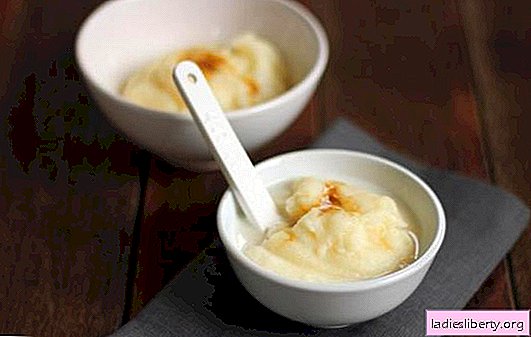
Semolina porridge is familiar to everyone since deep childhood.
Someone likes the classic version, cooked in milk or water, and someone likes porridge with the addition of fruits or berries.
But, we can definitely say that there is no such food product that would provoke as many conflicting opinions about the benefits and harms as semolina.
Features of the proper preparation of semolina porridge
The taste and benefits of semolina porridge directly depend on the method of its preparation. First of all, you need to choose the right cereal. Three types of semolina go on sale:
• from hard varieties with marking - T;
• from soft. Marking - M;
• from mixed - MT.
For cereal, only cereals from soft varieties are suitable. You can cook it both in water and in milk. But it is worth considering that a dish prepared in milk will be high-calorie. The fatter the selected milk, the more caloric porridge. At the same time, semolina protein is assimilated only if the dish is cooked on a milk basis. The standard ratio for mild porridge will be 7 teaspoons per 200 ml of milk.
So that cooking is not a problem, it is necessary to observe some nuances at all stages of the procedure:
1. Cooking porridge is recommended in an aluminum pan. To avoid burning, you need to pour a couple of spoons of cold water at the bottom. After this, pour the milk and wait for it to boil.
2. Add sugar or honey. If the dish is prepared for an adult, then these ingredients are added to taste. If porridge is intended for a child, then it is better to exclude honey, and add sugar in a minimum amount - about 6 grams.
3. Add a pinch of salt.
4. Continuously stirring the boiled milk, pour in a thin stream of groats. The intensity of stirring will help to eliminate the appearance of lumps.
5. Allow the mass to boil and reduce to the smallest power. The final density of the prepared porridge and the preservation of useful properties depend on the cooking time. In order to get an average density, do not cook for more than 7 minutes. For a more viscous mass, you can cook for 12 minutes. But do not keep the dish on fire for more than 15 minutes - this deprives it of all useful properties.
6. Remove the prepared porridge from the heat and add butter (about 5 grams), fruits, berries or various spices as desired. Great for cinnamon semolina. Such a tandem helps to normalize digestion. Do not combine semolina with foods high in carbohydrates, such as dates.
Semolina with the same success can be prepared in a slow cooker. To do this, add to the pan:
• 400 ml of milk or water;
• 50 g semolina;
• 0.5 teaspoon of salt;
• 1.5 tablespoons of sugar;
• butter if desired.
Then close the lid and set the appropriate mode. The harm from semolina prepared in this way will be minimal.
What is the use of semolina porridge?
This food product causes a lot of controversy about its beneficial properties. In some situations, the use of this dish is not recommended. But for the most part semolina brings undeniable benefits. This is due to the chemical composition of the product, which includes a wide range of vitamins, micro and macro elements. Due to the high content of potassium and magnesium, semolina contributes to the active restoration of normal heart function. Therefore, porridge is introduced into the diet for diseases of the cardiac and vascular system. Also, this product is indicated in the postoperative period, since vitamin E, located in the cereal, favors the speedy healing of body tissues. Eating semolina porridge makes up for the lack of iron and restores normal hemoglobin levels. The presence of zinc in cereals ensures the normal functioning of the liver. A whole group of vitamins B supports immunity, helps strengthen the nervous system and increases the efficiency of brain receptors. Large amounts of calcium in cereals help strengthen teeth and bones. Semolina is indicated for chronic kidney diseases, as cooked in water, it does not allow the body to absorb proteins. Gastroenterologists consider semolina an indispensable product for diseases of the stomach and esophagus. Possessing an enveloping effect, it relieves cramping, removes intestinal mucus and toxins, and prevents the occurrence of malignant tumors. The combination of all the useful elements and vitamins in the porridge allows you to restore your vitality and energy potential in a short time.
The harm of semolina: fiction or, right?
Unfortunately, semolina has not only a beneficial effect. Some of its features cause great harm to the body, causing a number of pathologies and side effects. The cereal is saturated with a viscous substance - gliadin (gluten), which can cause the death of the villi of the esophagus. As a result, diarrhea, intestinal colic, stomach cramps occur.
In addition, the accumulation of gliadin leads to the occurrence of eczema and pain in the joints and ligaments.
Phytin contained in cereals significantly slows down the absorption of nutrients and promotes the excretion of calcium from the body. Often this leads to increased fragility of bone tissue. In this regard, the elderly are recommended to limit the consumption of semolina. Frequent use of this product leads to constipation, especially if the amount of water entering the body is limited.
Semolina porridge is a high-calorie dish and has a high glycemic index, which promotes quick weight gain. Therefore, people prone to overweight frequent consumption of such a product is not recommended. Strict contraindications to the introduction of semolina porridge in the diet are diabetes mellitus and celiac enteropathy.
Pediatricians have a special attitude towards semolina porridge. Modern doctors do not recommend introduce this product into the diet while the child is less than 3 years old.
This is due to the fact that the digestive system of the child is not able to cope with a large amount of carbohydrates that are contained in semolina porridge.
This leads to bowel dysfunction: diarrhea or constipation. In addition to this factor, there is another one that also negatively affects the functioning of the esophagus. This factor is the presence of gluten in the cereal. Released in the intestine, it aggressively acts on its mucous surface, gradually thinning it.
Phosphorus is present in semolina, which accumulates in the body and blocks the flow of calcium into the blood.
If you feed the baby regularly at least 3 times a day with such a dish, then the calcium level will be replenished only from bone tissue.
At the same time, gliodin contained in cereals prevents the absorption of beneficial substances that promote the penetration and better absorption of incoming calcium.
As a result, the child first has an acute deficiency of vitamin D, and then rickets or spasmophilia may occur.
What is useful and harmful semolina porridge for pregnant and lactating mothers?
During pregnancy, special attention should be paid to the diet and diet. The woman’s menu should be varied and, most importantly, complete. During this period, doctors recommend including semolina porridge in their menu. It must be alternated and consumed about 3 times a week, no more. Naturally, the use of this product should not be excessive, since semolina has both positive and negative effects on the pregnant woman's body.
The benefits of semolina porridge:
• the composition of the product contributes to the complete assimilation of all substances in a short period of time, without causing a feeling of oversaturation and discomfort in the stomach;
• such a dish helps to quickly restore energy potential;
• cholesterol is completely absent in semolina semolina. For pregnant women, this is an important indicator, since in this period an increase in blood pressure is often observed;
• with exacerbation of gastritis, semolina porridge will be an indispensable tool. It gently neutralizes the aggressive effect of acid on the walls of the stomach;
• during pregnancy, this food product is recommended as a body cleanser. To do this, it is worth introducing porridge cooked on water in the morning menu.
Harm from semolina porridge:
• high calorie content of such a dish can provoke a set of extra pounds, which is a problem for pregnant women;
• the presence of gluten can provoke an allergy in both the mother and the child in the future. Often, allergic manifestations cause serious pathologies of the fetus;
• with frequent use, a decrease in the intake of iron is possible, which leads to the occurrence of anemia.
The undoubted benefit of semolina for children
The benefits of semolina for the development of the body of children are undeniable. The main point is the correct and timely introduction of it into the diet of the child.
First of all, it is necessary to remember that feeding her a baby younger than a year is not recommended. An organism at this age is in the stage of active growth.
An unformed nutrition system is not able to fully cope with so many nutrients and elements.
After a year, this dish is added to the menu only because the cereal is rich in vitamins and micro and macro elements necessary for the child. Up to three years, the portion should be small, once a day and no more than 2 times a week.
The use of porridge by children under three years of age is indicated in case of insufficient weight or severe dystrophy.
The presence of proteins and starch contribute to the rapid gain in body weight, mainly due to the growth of muscle tissue. But even in this case, do not exceed the use of cereal more than once a day.
Semolina contains a very important enzyme - phytinase, which regulates the metabolic process of substances and helps to increase immunity.
Semolina porridge is a useful product that will help the whole body, if used correctly. Make your diet complete and varied, and then nutrition will only bring benefits.











